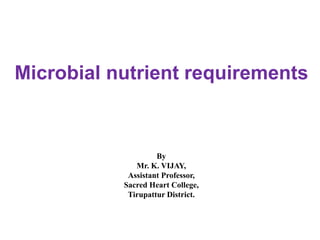
Microbial nutrient requirements
- 1. Microbial nutrient requirements By Mr. K. VIJAY, Assistant Professor, Sacred Heart College, Tirupattur District.
- 2. Every organism must find in its environment all of the substances required for energy generation and cellular biosynthesis. The chemicals and elements of this environment that are utilized for bacterial growth are referred to as nutrients or nutritional requirements. Many bacteria can be grown the laboratory in culture media which are designed to provide all the essential nutrients in solution for bacterial growth. Bacteria that are symbionts or obligate intracellular parasites of other cells, usually eukaryotic cells, are (not unexpectedly) difficult to grow outside of their natural host cells. Whether the microbe is a mutualist or parasite, the host cell must ultimately provide the nutritional requirements of its resident.
- 3. Analysis of microbial cell composition shows that over 95% of cell dry weight is made up of a few major elements: carbon, oxygen, hydrogen, nitrogen, sulfur, phosphorus, potassium, calcium, magnesium, and iron. These are called macroelements or macronutrients because they are required by microorganisms in relatively large amounts. The first six (C, O, H, N, S, and P) are components of carbohydrates, lipids, proteins, and nucleic acids. The remaining four macroelements exist in the cell as cations and play a variety of roles.
- 5. For example, potassium (K+) is required for activity by a number of enzymes, including some of those involved in protein synthesis. Calcium (Ca+2), among other functions, contributes to the heat resistance of bacterial endospores. Magnesium (Mg+2) serves as a cofactor for many enzymes, complexes with ATP, and stabilizes ribosomes and cell membranes. Iron (Fe+2 and Fe+3) is a part of cytochromes and a cofactor for enzymes and electron-carrying proteins.
- 6. All organisms, including microorganisms, require several micronutrients or trace elements besides macroelements. The micronutrients - manganese, zinc, cobalt, molybdenum, nickel, and copper—are needed by most cells. However, cells require such small amounts that contaminants in water, glassware, and regular media components often are adequate for growth. Therefore it is very difficult to demonstrate a micronutrient requirement. In nature, micronutrients are ubiquitous and probably do not usually limit growth.
- 7. Micronutrients are normally a part of enzymes and cofactors, and they aid in the catalysis of reactions and maintenance of protein structure. For example, zinc (Zn+2) is present at the active site of some enzymes but is also involved in the association of regulatory and catalytic subunits in E. coli aspartate carbamoyltransferase. Manganese (Mn+2) aids many enzymes catalyzing the transfer of phosphate groups. Molybdenum (Mo+2) is required for nitrogen fixation, and cobalt (Co+2) is a component of vitamin B12.
- 8. Besides the common macroelements and trace elements, microorganisms may have particular requirements that reflect the special nature of their morphology or environment. Diatoms need silicic acid (H4SiO4) to construct their beautiful cell walls of silica [(SiO2)n]. Although most bacteria do not require large amounts of sodium, many bacteria growing in saline lakes and oceans depend on the presence of high concentrations of sodium ion (Na). It must be emphasized that microorganisms require a balanced mixture of nutrients. If an essential nutrient is in short supply, microbial growth will be limited regardless of the concentrations of other nutrients.
- 9. Element % of dry weight Source Function Carbon 50 organic compounds or CO2 Main constituent of cellular material Oxygen 20 H2O, organic compounds, CO2, and O2 Constituent of cell material and cell water; O2 is electron acceptor in aerobic respiration Nitrogen 14 NH3, NO3, organic compounds, N2 Constituent of amino acids, nucleic acids nucleotides, and coenzymes Hydrogen 8 H2O, organic compounds, H2 Main constituent of organic compounds and cell water
- 10. Element % of dry weight Source Function Phosphorus 3 inorganic phosphates (PO4) Constituent of nucleic acids, nucleotides, phospholipids, LPS, teichoic acids Sulfur 1 SO4, H2S, So, organic sulfur compounds Constituent of cysteine, methionine, glutathione, several coenzymes Potassium 1 Potassium salts Main cellular inorganic cation and cofactor for certain enzymes
- 11. Element % of dry weight Source Function Magnesium 0.5 Magnesium salts Inorganic cellular cation, cofactor for certain enzymatic reactions Calcium 0.5 Calcium salts Inorganic cellular cation, cofactor for certain enzymes and a component of endospores Iron 0.2 Iron salts Component of cytochromes and certain nonheme iron-proteins and a cofactor for some enzymatic reactions